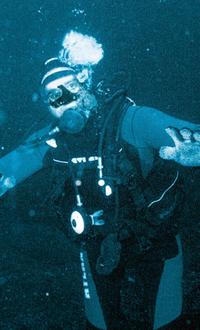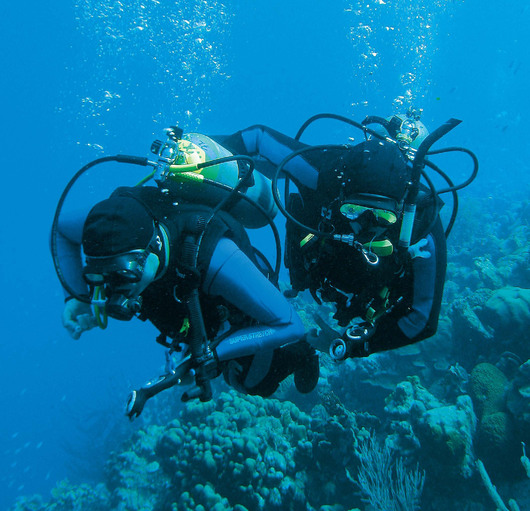Scuba Diving Offers Fun and Freedom

My name is Wayne MacDonald and I was injured on February 8, 1999. After six-plus months of rehab and pulling the pieces of my life together, I began exploring what I could do with my new normal.
I quickly got back into aviation with the Brampton Flight Centre, flying the skies in a Warrior PA-28 aircraft. I was eager to explore the world from other unique perspectives that would also allow me to have the freedom of leaving my chair behind.
I signed up for training with the Adaptive Scuba Association shortly after my injury. I was viewed as a natural by my dive instructor, who asked me to help present the program to dive organization directors in Kingston, Ont., and Orlando, Fla., along with the abilities of divers with disabilities. This was a great honour for a newbie like me. I did not take the open-water tests that would have given me my
certification.

A few years passed before Kevin Rogers of the Canadian Paraplegic
Association told me about Freedom at Depth. Hubert Chrétien ran the
PADI course from his home in Gatineau, Que., for the Handicap Scuba
Association of Canada. Kevin, who has quadriplegia, was in the final
stages of certification! I contacted Hubert and arranged to train with
him for a week. Once I arrived, I was introduced to Leo, my able-bodied
dive partner.
Our first day in the water involved basic
training. The first things were a mandatory swim test of 200 yards and
treading water for 10 minutes to verify my fitness level. (Participants
also need approval from their physicians, and good eyesight is an
asset.) I was instructed on the equipment that recreational divers use,
and how to set it up and maintain it.
Diving is all about the
buddy system, and Leo was as enthusiastic as I was. We began with the
proper set-up of the gear on the deck. We had to check the integrity of
the whole system as it was assembled, checking the tank, hoses and O
rings for signs of stress. Each and every check is verified with your
buddy.
Due to the weight of the equipment, I soon learned I
would need assistance for parts of my gear set-up. I could transfer
myself onto the pool deck, and there was a Hoyer lift for anyone who
required assistance. I was instructed on the proper entry procedures to
experience the freedom of weightlessness. In my case, I sat on the very
edge of the pool and balanced myself while someone helped me put on the
vest and tank. All straps were secured, and a final air check was
performed by my buddy.
I inched to my personal pivot point (the
position in which a diver can sit up, balanced, with equipment on),
then fell forward into the water with a full vest of air. Turning over,
I gave the OK sign.

The first lesson was buoyancy control. The lack of leg control will be a factor for everyone – my legs float on the surface, but others’ legs may sink. We tried various leg weights to get it just right. When you’re at depth – the neutral point where you are no longer rising or falling in the water – your body needs to be as horizontal as possible. It makes your movements easier.
To stay neutral, we use weights to counteract the flotation caused by the vest. Weights for divers with disabilities are distributed in the vest, on a waist belt and even around the ankles to help achieve being horizontal at depth. This will change depending on where you are diving; for example, salt water is more buoyant than fresh water.
Each evening, we watched instructional videos and read, read, read. Written tests and a final exam were also required.
I soon found out I wouldn’t be as comfortable as I’d thought. There were many skills we needed to do, such as clearing a flooded mask, proper breathing from a regulator, and shared air experience, which involves sharing one tank with your buddy. During some of the out-of-air buddy breathing exercises, I had mild panic attacks when I thought we were low on air.
Ascending and descending at a proper speed can’t be stressed enough. Ascents especially require stops to allow built-up nitrogen to escape from the bloodstream. Not following dive tables could result in serious internal injuries. Coughing water out underwater can be very uncomfortable the first time, but with continued practice, I got the hang of it.
A huge asset in enjoying the underwater experience is using your lungs for buoyancy. With minor breathing techniques, you can raise and lower yourself by mere inches effortlessly at depth. Don’t get in the habit of relying on your vest. It is essential for keeping you at the surface upon entry; it deflates to let you descend and have neutral buoyancy at depth. Short spurts of air will assist the ascent. Your lungs are the fine-tuning components as you explore the magic of the dive.
One of the greatest moments came from the out-of-air exercises. You get your buddy’s attention with an out-of air signal. You both begin a shared-air ascent. Once at the surface, you manually inflate your vest. The catch is that with no leg movement, you have to time your air intake above and inflate below the surface until enough air is in the vest to keep your head above water. This is the difference between Class A and B divers. (The classes dictate how much supervision you must have when in the water.) I was successful in the pool, but I’d have to pull it off in open water to be a Class A unrestricted diver.
To receive my diving certification, I had to complete five open-water dives. In September of 2006, I took the plunge into the St. Lawrence River near Belleville, Ont. I completed all the requirements along with the proper inflation of an out-of-air vest. I was in class A, baby!
Since that weekend, I have explored wrecks in the St. Lawrence River, done night dives and drift dives (where you enter the water in one place, and drift with the current to another), played with sea lions in the Sea of Cortez, and explored the mushroom forests off the coast of Curaçao, and I feel like I’ve only scratched the surface. Every dive has been full of adventure. Your fellow divers are just like family, always willing to lend a hand. If you love water and enjoy the great outdoors, try scuba diving!














